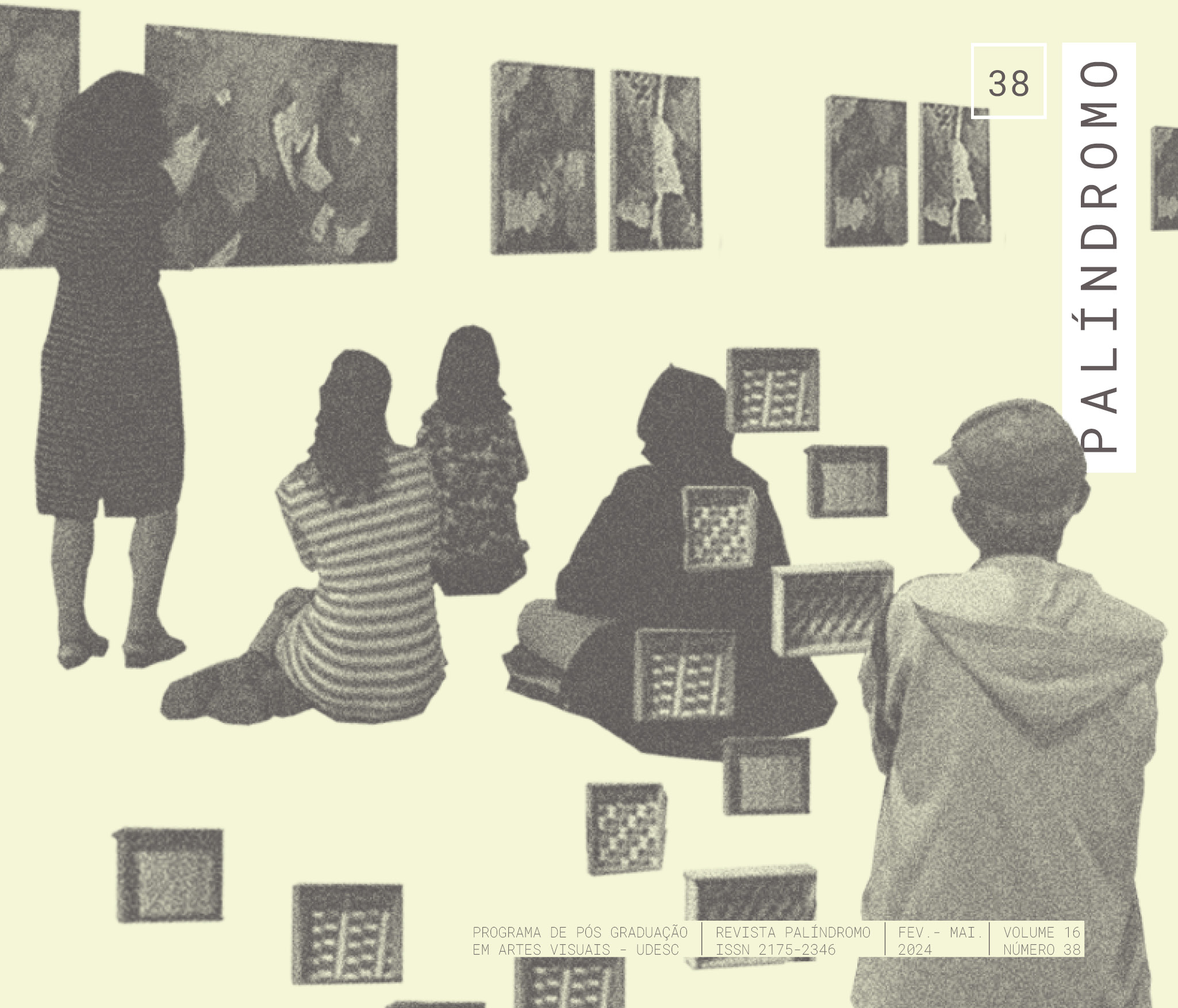A social and cultural context to read children's drawing processes
DOI:
https://doi.org/10.5965/2175234616382024e0007Keywords:
children's drawing, graphic language, sociocultural interaction, context, community, art educationAbstract
This article is part of a doctoral research process in the area of analysis and interpretation of children's drawing processes and behaviors. The objective of the text is to study and propose some questions regarding the sociocultural and psychosocial dimensions of these processes in preschool boys and girls, in conversation with the biological, anthropological and physical dimensions that appear most often in children's first drawings. We intend to contribute to children's reading and understanding of graphic language. Our methodology is inserted in artistic and image-based research, since it aims to establish the relationship between multiple theories and studies (state of the art) and our collections of photographic and videographic material that collect direct observations of children's drawing processes (in a broad sense). As a result, we created our own analysis questions and categories and then applied them to the processes and their transcription. Provisionally, it seems to us that young children are permeable to the sociocultural context in the close and immediate environment of direct social interactions during the processes, while older children reflect in their drawings the culture and society of which they are part and in which they have grown up and been educated. Furthermore, it is important to point out that this approach to children's drawing leads us directly to the study of drawing as behavior, as a language and knowledge that is deeply human and embedded in both culture and the biophysical nature of the world.
Downloads
References
ANNING, A. (2002). Conversations around young children’s drawing: The impact of the beliefs of significant others at home and school. International Journal of Art and Design Education, vol 21, nº 3, 197–208. DOI: https://doi.org/10.1111/1468-5949.00317
ARNHEIM, R. (1979, 1a ed. 1954): Arte y percepción visual. Alianza Editorial.
BALDY, R. (2009). Dessine-moi un bonhomme . Universaux et variantes culturelles. Gradhiva, 9 DOI: https://doi.org/10.4000/gradhiva.1432
BARD, K. (2008). Understanding reflections of self and other objects. In C. Lange-Küttner & A. Vinter (Eds.), Drawing and the Non-Verbal Mind: A Life-Span Perspective. Part I: Self, Symbols and Intention (pp. 23-41). Cambridge: Cambridge University Press. doi:10.1017/CBO9780511489730.002 DOI: https://doi.org/10.1017/CBO9780511489730.002
BROOKS, M.L. (2003a). Drawing to Learn. Young Children: beyond the journal, September. Washington: National Association for the Education of Young Children. Available at: http://www.journal.naeyc.org/btj/200309
BROOKS, M.L. (2003b) Drawing, Thinking, Meaning, TRACEY [an electronic journal about contemporary drawing issues]. Loughborough: University of Loughborough. Available at: http://www.lboro.ac.uk/ departments/ac/tracey/thin/brooks.html
BROOKS, M. (2005). Drawing as a unique mental development tool for young children: interpersonal and intrapersonal dialogues.- Contemporary Issues in Early Childhood, Vol. 6, nº 1, University of New England, Armidale, Australia. DOI: https://doi.org/10.2304/ciec.2005.6.1.11
CHANGEUX, J.P. (1997). Razón y placer. Barcelona, Tusquets.
COHN, N. (2012). Explaining “I can’t draw”: Parallels between the structure and development of language and drawing. Human Development. 55(4): 167-192 DOI: https://doi.org/10.1159/000341842
COX, M. (1998). Drawings of people by Australian Aboriginal children: The intermixing of cultural styles. Journal of Art and Design Education, 17(1), 71–79. DOI: https://doi.org/10.1111/1468-5949.00107
COX, M., Perara, J., & Fan, X. (1999). Children’s drawing in the UK and China. Journal of Art and Design Education, 18(2), 173–181. DOI: https://doi.org/10.1111/1468-5949.00171
COX, M., KOYASU, M., HIRANUMA, H. & PERARA, J. (2001). Children's human figure drawings in the UK and Japan: The effects of age, sex, and culture. British Journal of Developmental Psychology, 19(2), 275–292. https://doi.org/10.1348/026151001166074 DOI: https://doi.org/10.1348/026151001166074
FEIN, S. (1993). First Drawings: Genesis of Visual Thinking. Pleasant Hill. CA: Exelrod Press
GOLOMB, C. (2004). The Child's Creation of A Pictorial World. New York: Psychology Press Taylor & Francis Group (formerly published by the University of California Press, Berkeley and Los Angeles, 1992) 340-341
GOMEZ MOLINA, J.J. (coord.) (1995): Las lecciones del dibujo. Madrid: Cátedra.
HAUSER, A. (2004): Historia social de la literatura y del arte. Debolsillo. (1a edición: 1951)
JOLLEY, R. P. (2010). Children and pictures: Drawing and understanding. West Sussex, U.K.: Wiley – Blackwell.
KELLOGG, R. (1979, 1981). Análisis de la expresión plástica del preescolar. Madrid: Cincel-Kapelusz.
MATTHEWS, J. (2002). El arte de la infancia y de la adolescencia. Col. Arte y educación. Barcelona, Paidós. (1ª ed. 1999)
PAGET, G.W. (1932). Some drawings of men and woman made by children of certain non-European races. Journal of the Royal Anthropological Institute, 62, 127-144 DOI: https://doi.org/10.2307/2843881
ROSS, J. (2008). Drawing production, drawing re-experience and drawing re-cognition. In C. Lange-Küttner & A. Vinter (Eds.), Drawing and the Non-Verbal Mind: A Life-Span Perspective. Part I: Self, Symbols and Intention (pp. 42-62). Cambridge: Cambridge University Press. doi:10.1017/CBO9780511489730.003 DOI: https://doi.org/10.1017/CBO9780511489730.003
WILLATS, J. (2005). Making sense of children's drawings. Lawrence Erlbaum Associates Publishers. DOI: https://doi.org/10.4324/9781410613561
WILSON, B., WILSON, M. & HURWITZ, A. (2004). La enseñanza del dibujo a partir del arte. Barcelona, Paidós.
WILSON, B. & WILSON, M.(1979). Figure Structure, Figure Action, and Framing in Drawings by American and Egyptian Children. Studies in Art Education, 21(1) DO - 10.2307/1319502 DOI: https://doi.org/10.2307/1319502
WOLFF, J. (1998). La producción social del arte. Akal. (1ª ed. 1981)
YAMAGATA, K. (1997). Representational activity during mother-child interaction: The scribbling stage of drawing. British Journal of Developmental Psychology, 15, 355-366 DOI: https://doi.org/10.1111/j.2044-835X.1997.tb00526.x
Downloads
Published
How to Cite
Issue
Section
License
Copyright (c) 2024 Muntsa Calbó i Angrill, Imma Panadès

This work is licensed under a Creative Commons Attribution 4.0 International License.
COPYRIGHT STATEMENT
The articles published by the magazine are free to use, intended for academic and non-commercial applications. Copyright is all assigned to the magazine. The articles whose authors are identified represent the expression from the point of view of their authors and not the official position of Palíndromo Magazine. The author (s) commits to whenever they publish material referring to the article published in Palíndromo mention this publication as follows:
This article was originally published by Palíndromo magazine in its volume (place the volume), number (place the number) in the year of (place the year) and can be accessed at: http://www.revistas.udesc.br/index.php/palindromo


